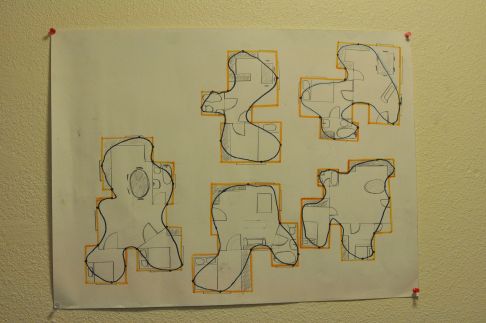While reading The Poetics of Space I have found myself frequently in conflict with Gaston Bachelard’s means of addressing ideas related to the experiences and sensations that one has in relation to architectural spaces. Specifically the objective manner in which he presents his own ideas and experiences is one that does not care to acknowledge that all of the experiences he is describing are derived from specific sociocultural ideas and narratives that in no way constitute any inherent experience within the settings that he describes. I find this to be problematic and have been considering a means to employ an architectural study that imposes a set of values on a space that those do not already exist within, and draft an interior layout within the limits of the space that is produced. With this project I have created a series of random amorphous shapes that do not immediately signify any architectural idea. From this point I used drafting rulers to create a contour that allows these amorphous shapes to be defined by straight lines and right angles, with occasional obtuse angles where necessary. The product of this step was a series of blocky asymmetrical shapes, within which I then imposed traditional modern interior values in the space that the Cartesian definition of the shapes aloud for, due to the fact that they are defined by, and dependent on, a Cartesian layout of perpendicular lines and corners in order to function in the first place.

Compact Cabins has been an excellent resource for
Compact Cabins has been an excellent resource for me in terms of providing a more in depth exposure of cabin architecture by providing drafts and floor plans and solutions for maximizing the use value of space. One of my favorite ideas thus far in this book is that of an elevated twin bed at a standard top bunk height, up against a wall. This space underneath the bed is then filled with a reading nook with a chair and table, which not only makes efficient use of the space, but does so in a manner that really adds to a reading nook setting, my making it more compact and cozy. Included is an illustration from Compact Cabins
Cabin Design: A-frame with Loft Access Treehouse Balcony
I have bee reading Compact Cabins: Simple Living in 1000 Square Feet or Less by Gerald Rowan, which provides drafting plans and exterior sketches for cabins, cottages, and other small living spaces. In response to my reading I have decided to create a draft with a two dimensional exterior sketch of my own. The cabin that I have design is an A-frame style cabin with a roof that extends all the way to the ground, providing storage space for firewood and anything else really. This design incorporates some of my most beloved features of the cabins that I have been researching. Among these are the spiral staircase, a wood burning fireplace, a bedroom loft, a compact sink and cooktop, and a tree house patio that is accessed by the loft. In drafting floor plans I have attempted to maximize the use value of space with features such as a stow away/fold out table, the compact spiral stair, and the roof extension storage on both sides of the cabin. Additionally I devised a system for covering the loft tree balcony that involves a pull out tarpaulin system with attachment hooks on the balcony railing. I experimented with a few different interior layouts when designing the interior of the first floor, such as having the stairs in the front right hand corner and the large window in the back center, and eventually settled on the layout that I felt provided the most open space with the least sacrifice of potential use value
